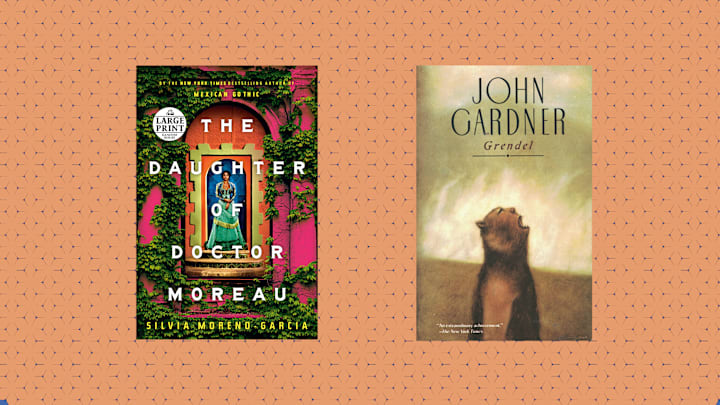Few genres are as interested in reimagining tradition as horror. Nosferatu (1922) was made because filmmakers couldn’t get the rights to Dracula from Florence Stoker, but what are you gonna do—not put a vampire in the nascent medium of film?
Monsters have continued to be rebooted in movies, but the limits of Hollywood often means those stories are typically updated re-tellings. Announce that you’re making a Frankenstein movie, and the audience wants to see some “it’s alive” action. Literature, though, is where fascinating re-imaginings happen. Below are 11 contemporary literary works that put a new spin on classic monsters.
1. Red // Chase Berggrun

Erasure is a form of poetry that takes a text and mines it for new meanings by removing words, whole paragraphs, or even entire characters. Chase Berggrun’s Red takes Dracula and strips the epistolary novel into a 27-chapter long poem exploring gender and transition. The entire concept of monsterhood is achingly deconstructed from a transgender perspective. Unlike Dracula, this book is one that does not need literal vampires and Victorian power structures to be harrowing.
2. Hooked // A.C. Wise

Instead of the crocodile-avoidant, nefarious swashbuckler we know from Hook (1991), what if Captain James Hook was a long-suffering immortal? Furthermore, what if he was resurrected over and over again, Westworld-style, to play a role in the twisted imagination of the Boy Who Wouldn’t Grow Up? A.C. Wise’s novel re-casts Neverland as a sinister shadow of Peter Pan, with a loose-in-London Captain Hook hellbent on revenge.
3. Autobiography of Red // Anne Carson

Incorporating her own translations of the fragments of Stesichorus’s “Geryoneis” poems, Anne Carson’s novel transports the red-winged monster Geryon and his would-be murderer Herakles to a contemporary landscape. Rather than fulfilling a divine mission to kill the monstrous cow herder, Heracles becomes Geryon’s lover in this queer bildungsroman. Line-to-line, the novel is laser-focused and precise, proving teenage love can be every bit as devastating as epic quests.
4. “The Devourings” From The Color Master // Aimee Bender

No list like this is complete without a mention of Aimee Bender’s work. She’s one of the first names mentioned in discourse on modern fairy tales—even her stories without overt nods to the fantastical feel uncanny and mystical. “The Devourings,” one of the short stories within The Color Master, takes the Shrek-and-Fiona dynamic of a human woman married to an ogre and injects it with tragedy and a search for belonging.
5. The Bloody Chamber And Other Stories // Angela Carter

Bring up Aimee Bender and you beg a reference to Angela Carter, whose short story “The Bloody Chamber” is masterfully dissected by Bender here. The story itself is a marvelous retelling of Bluebeard, perhaps the ultimate misogynist of literature.
6. The Daughter of Doctor Moreau // Silvia Moreno-Garcia

If you’re going to revisit the story of the mad scientist and his human-animal hybrids, why not set it against the lush canvas of 19th-century Mexico? Moreau’s perfectly balanced world—a tranquil oasis of an estate set apart from conflicts on the Yucatán—is upended as passions erupt in the jungle.
7. Lovecraft Country // Matt Ruff

What does literature do with a massively influential, genre-defining writer like H.P. Lovecraft, whose virulent racism was a feature, not a bug, to his conceptualization of cosmic horror? One option is to take Lovecraft’s themes and put them in the hands of POC characters. Lovecraft Country has stories of sundown towns and cacophonous neighborhood integration, showing that the cosmic indifference of the universe has nothing on the outrageous terrors of violent racism.
8. The Mere Wife // Maria Dahvana Headley

For a text with a claim to a spot on the “great epics” shelf, Beowulf sure does involve a lot of dudes sitting around and congratulating themselves. Know who else likes to sit around congratulating themselves? American suburbanites. Maria Dahvana Headley’s novel turns Grendel’s Mother into Dana Mills, a mysteriously pregnant marine living just above the idyllic town of Herot Hall. Her child, Gren, eventually wants to mingle with the people of Herot Hall, leading to epic violence that could only happen in the contemporary United States.
9. Grendel // John Gardner

All lists are incomplete somehow, but this list would be especially incomplete without a nod to the OG literary monster update. If your high school English teacher didn’t already use this novel as an introduction to postmodernism, do yourself a favor and check out the monster’s take on the whole “Beowulf comes to Heorot” situation.
10. The Book of Renfield: A Gospel of Dracula // Tim Lucas

We end the book portion of this list as we began, circling back to the immortal vampire and his Tom Waits-looking, “old lady who swallowed a fly”-emulating sycophant, Renfield. This tome collects Renfield’s case files with Dr. Seward and reveals a lot more about the tortured soul, including his troubled childhood.
11. Dracula Beyond Stoker Press
Here’s a bit of bonus literature. This is neither a book nor unified text, but rather, the newly minted fiction journal Dracula Beyond Stoker. Issue #1 will be released in November 2022, with stories focusing on the continent-migrating Count himself; Issue #2 (forthcoming May 2023), will be based around Renfield. As all of the books in this list are literary retakes on classic spooky tales, these journals promise to amp that concept up to 11 and are definitely something for horror fans to keep an eye on.
